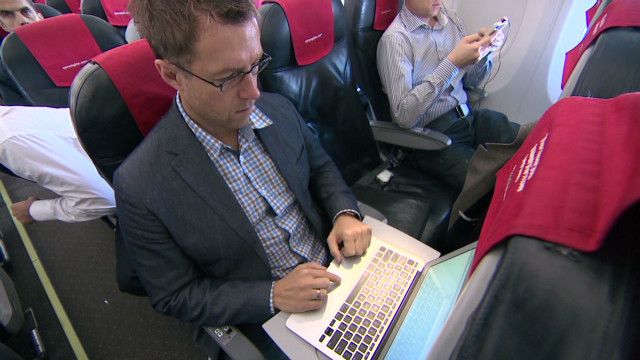
The rise of in-flight Wi-Fi
STORY HIGHLIGHTS
- More airlines providing Wi-Fi on their flights
- Norwegian Air first airline in Europe to offer free Wi-Fi
- Gogo system installed on 1,600 U.S. jets, according to CEO
- Row 44 provides satellite-based system that can access internet even over the ocean
By its own estimate, one
of the fastest-growing companies in America is Gogo, which was the first
to successfully hook up planes with internet. It has since installed
systems on several U.S. carriers, including Delta, American and US
Airways.
According to its CEO,
Michael Small, Gogo's profits grew from $37 million in 2009 to $112
million in the first six months of 2012.
"We're now on over 1,600
commercial aviation jets, which is nearly half the U.S. fleet. We've
done that in four years, which is extraordinarily fast," says Small. "In
just a few more years, it will be done in America."
Though airlines pay to
install the equipment, they also reap the rewards; Gogo charges the
customers for internet usage -- between $5 and $20, depending on flight
duration -- and shares its revenue with the carriers.
"More travelers are aware
of our service, and many of them want it," says Small. "One in five say
they will switch a flight to get our service."
The drawback with Gogo's
system is that it uses an air-to-ground network of cell phone towers it
built across the United States -- each with a 250-mile radius of
coverage -- meaning its wi-fi isn't available when flying over water.
Internet on Gogo-outfitted planes is therefore limited to domestic
flights. This is where California-based firm Row 44 swoops in.
Row 44 also installs
wi-fi on airplanes, though unlike Gogo, it relies on a satellite system,
meaning passengers can access internet even when flying over the ocean.
"This is a distinct
advantage, given that two-thirds of the planet is covered in water,"
notes John LaValle, Row 44's CEO. Also, satellite systems give
passengers more options, due to better bandwidth.
"Air-to-ground has
certain inherent limitations in terms of the amount of data that can be
processed through the network of cell towers on the ground -- for
example, live TV really is an impossibility," says LaValle, whose
company also offers that service as part of its package. "In a satellite
environment, you're able to get much more data through the pipe."
But the satellite system
is substantially more expensive than using cell-phone towers, and has
the added drawback of taking longer to install. As airlines lose money
for every day a plane is out of commission, this can make the process
rather costly. Some carriers, however, find it's worth the price.
Mango Airlines and
Southwest are among the airlines using Row 44's service, with Icelandair
soon to follow. What's more, Norwegian Air Shuttle, which has also
joined the fray, has just this month started offering wi-fi to
passengers free-of-charge -- the first airline in Europe to do so.
"We had a trial period
where we offered it free to passengers, and we saw increases on those
routes; it went up volumes," notes Boris Bubresko, head of business
development for Norwegian Air Shuttle. "After that, we decided to keep
it free."
At the moment,
connectivity is a perk; airlines that provide wi-fi or mobile services
on board stand out. This will change, though, as customers increasingly
start to expect the amenity, rather than merely appreciate it. LaValle
feels that era has already dawned.
He says: "I was on a
plane recently that wasn't wi-fi equipped, and this guy sitting across
the aisle opened up his laptop and he couldn't find the hotspot. He
slammed it down and said, 'I can't believe this, I really needed to get a
lot of work done on this flight!'
"I think we're already at that point where everyone fully expects connectivity."
Source: CNN







0 comments:
Post a Comment